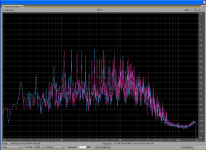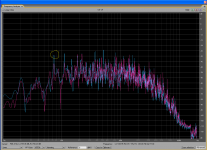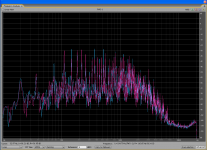Whats the magic number, when does it become audible ....
I'm curious what are the spectral characteristics of a single note on a real piano? The FFT's need some massaging to separate AM and FM or extract instantaneous frequency. I suspect a real piano is more AM than FM and the LP is both +.
and still the instantaneous turntable speed needs to be measured.
(re-)building an optical TT would be fun.
http://ethesis.unifr.ch/theses/downloads.php?file=StotzerS.pdf
We need time to distinguish the pitch of a tone.
In average, this time is 50ms for 100Hz tone, 20ms for 1kHz, 14ms for 4kHz. (*)
Therefore for rotational velocity stability studies using musical instruments recordings, a high pitch tone would be desirable (flute with constant blowing, old violin masters playing Bach dry, M.Callas clear sinusoid from her early years).
Clear notes from cello and piano are interesting for testing.
It’s the stable (over a given time interval) harmonic combination of the many partials of these notes that is affected by a slight rotational velocity variation that attracts our attention.
Pipe organ needs the building for which it was designed for, for to sound as “organ”.
The resonances of the various sub spaces are part of it’s sound, therefore, there are many time constants heard with distant miking, the norm for organ music recording.
(*) These time intervals suggest in theory that, a heavy platter driven by a non-slipping belt (long time-constant) has psychoacoustic advantages over light direct driven platters (short time-constant).
Appropriate velocity monitoring feedback loops and good engineered direct motors do exist though and defy the assumptions (e.g. have a look on Dual 701 motor/electronics )
Here are some synthesized files you can play for to hear acoustic effect of velocity modulation:
Test Tones
George
In average, this time is 50ms for 100Hz tone, 20ms for 1kHz, 14ms for 4kHz. (*)
Therefore for rotational velocity stability studies using musical instruments recordings, a high pitch tone would be desirable (flute with constant blowing, old violin masters playing Bach dry, M.Callas clear sinusoid from her early years).
Clear notes from cello and piano are interesting for testing.
It’s the stable (over a given time interval) harmonic combination of the many partials of these notes that is affected by a slight rotational velocity variation that attracts our attention.
Pipe organ needs the building for which it was designed for, for to sound as “organ”.
The resonances of the various sub spaces are part of it’s sound, therefore, there are many time constants heard with distant miking, the norm for organ music recording.
(*) These time intervals suggest in theory that, a heavy platter driven by a non-slipping belt (long time-constant) has psychoacoustic advantages over light direct driven platters (short time-constant).
Appropriate velocity monitoring feedback loops and good engineered direct motors do exist though and defy the assumptions (e.g. have a look on Dual 701 motor/electronics )
Here are some synthesized files you can play for to hear acoustic effect of velocity modulation:
Test Tones
George
(re-)building an optical TT would be fun.
http://ethesis.unifr.ch/theses/downloads.php?file=StotzerS.pdf
Doesn't seem to be real time. It turns out the dirt is sort of a show stopper for real time play of many disks.
Speed variations:
Assume we have managed to have the platter idle at a very constant speed.
Speed variation is to be observed (*) or measured with the cartridge reading the grooves.
The needle drag is considerable and varies with the groove’s modulation.
Whatever intervenes between the correctly rotating platter and the cartridge needle (that is, the the record and the platter mat), may cause pitch instability.
The record should not micro-slip in reference to the platter.
The pitch stability can be checked on the FFT of a single tone recording.
The top of the fundamental (say 300Hz) tone will indicate the rotational speed (if it is exact to the nominal speed or how much it deviates).
The tops of the harmonics ideally should be sharp at 600, 900, 1200, 1500…
If there is pitch instability, the tops of the harmonics will become wider, smooth or juggled.
Check this detail when evaluating platter mats. Check the highest odd harmonic visible.
George
(*) A strobe disk reading is to be trusted only for long term speed stability monitoring.
>Edit:
Check Glenn Gould recordings playing J.S.Bach
Assume we have managed to have the platter idle at a very constant speed.
Speed variation is to be observed (*) or measured with the cartridge reading the grooves.
The needle drag is considerable and varies with the groove’s modulation.
Whatever intervenes between the correctly rotating platter and the cartridge needle (that is, the the record and the platter mat), may cause pitch instability.
The record should not micro-slip in reference to the platter.
The pitch stability can be checked on the FFT of a single tone recording.
The top of the fundamental (say 300Hz) tone will indicate the rotational speed (if it is exact to the nominal speed or how much it deviates).
The tops of the harmonics ideally should be sharp at 600, 900, 1200, 1500…
If there is pitch instability, the tops of the harmonics will become wider, smooth or juggled.
Check this detail when evaluating platter mats. Check the highest odd harmonic visible.
George
(*) A strobe disk reading is to be trusted only for long term speed stability monitoring.
>Edit:
I'm curious what are the spectral characteristics of a single note on a real piano?
Check Glenn Gould recordings playing J.S.Bach
Last edited:
Good and interesting input, George. You have obviously done your 'homework'. I have never figured out how to test for speed changes with extra needle drag. Perhaps a slowly continuously rising amplitude square wave test tone would be useful. I think that your evaluation of the harmonics is great!
Doesn't seem to be real time. It turns out the dirt is sort of a show stopper for real time play of many disks.
What if we took away the real time constraint?
I'm curious what are the spectral characteristics of a single note on a real piano? The FFT's need some massaging to separate AM and FM or extract instantaneous frequency. I suspect a real piano is more AM than FM and the LP is both +.
Here is bottom D on the piano and an MP3 of it. More harmonics than you can shake a stick at.
Attachments
It is true that the pchannel jfets are very costly. However, that is what is available, and IF you want to make complementary differential input stages, then this is the way to do it.
For example, I remember when I could buy a matched pair of Genelex KT88 power output tubes for $11 or so. Not lately, however.
We manufacturers also have to pay plenty for these devices, but we are gritting our teeth and going forward.
For example, I remember when I could buy a matched pair of Genelex KT88 power output tubes for $11 or so. Not lately, however.
We manufacturers also have to pay plenty for these devices, but we are gritting our teeth and going forward.
Here is bottom D on the piano and an MP3 of it. More harmonics than you can shake a stick at.
There also seems to be lots of sympathetic vibrations even at lower frequencies.
Here is bottom D on the piano and an MP3 of it. More harmonics than you can shake a stick at.
I hope you do not mind me posting analysis of your file
Attachments
I hope you do not mind me posting analysis of your file
Is low D ~73Hz on a piano?
That's what is in the file, the middle stroke (there are 3 successive strokes). You can see 73Hz at some -46dB.
I was just wondering since the first stroke had less high harmonic energy to me. I have access to a big Steinway maybe I should try it myself.
- Status
- Not open for further replies.
- Home
- Member Areas
- The Lounge
- John Curl's Blowtorch preamplifier part II



